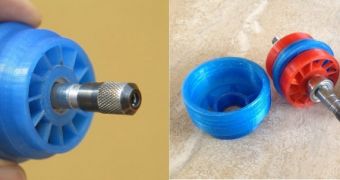Plastic isn't something you expect to survive intense friction, not without warping or melting, but there are other motions it can get through, like rapid rotation. Going by that knowledge, one Richard Macfarlane made a 3D printed turbine.
Richard Macfarlane is a retired mechanical design engineer from Perth, Australia, who sometimes invents things in his spare time.
The 3D printed turbine in the image above is his latest creation, made with a MakerBot Replicator 2 3D printer.
In truth, the turbine is something he made last year on a whim, and whose 3D CAD file he posted on Thingiverse at some point afterwards, pro bono.
He put it there so that anyone could use it, since he hadn't dreamed up any uses for it. None beyond the original one anyhow: car propulsion.
The designer got the idea for the turbine when he found a different model on Thingiverse, a design for a car that could direct a balloon's air backwards, thus propelling the card forward. The car had an opening on top for the balloon. Macfarlane thought a turbine would work better, so he made one.
It was only after he made the calculations on its speed that he realized that he’d outdone himself. The thing can actually spin at 6,000 RPM (rotations per minute).
Part of the speed is the size: the turbine is pretty small, a bit smaller than a chicken egg in fact, which is part of it.
The smaller something is, the better it can stay together, especially if it's made of a single piece. Not that the turbine is. It's made of several pieces, held together by a steel central rod (which isn't 3D printed, not that the MakerBot Replicator 2 even could do it, being a plastic maker and all, not metal welder).
Macfarlane could have probably made a fortune if he marketed the thing. It may be small and unassuming, but it could be used in lots of things, like rotors, wheels, etc.
For those who want details, the turbine is a two-stage turbine, with a pair of statuary stators, whose role is to twist the air. There are two rotors too, which do spin. This isn't just a mockup after all.
To test the work of the turbine, Macfarlane mounted the turbine on a Dremel with a sanding disk on the end. The dust resulting from the sanding process was neatly aspirated, leaving none behind.
To install the turbine, or a larger, maybe metal version of it, in a car, you would need some extra gears for a transmission. Not a particularly daunting task, but one that the designer didn't feel inclined to pursue. He'd started out with a toy after all, and didn't feel the need to trouble himself with commercializing it at the time.

 14 DAY TRIAL //
14 DAY TRIAL // 